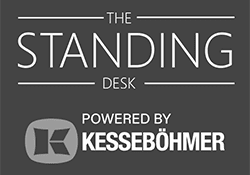Do standing desks fix back pain?
Do they eliminate it? Do they help with back pain at all? It’s no question that many people wonder how much of a difference standing desks make. Here we look at how they affect health and the right ratio of sitting to standing for each person.
Is standing inherently better than sitting at work?
Anyone who has experienced lower back pain after working all day is bound to wonder whether the pain just might be tied to their daily tasks. If you work in a desk job, you’re more than likely sitting for 8-11 hours a day. Can sitting too much cause back pain?
Is sitting really the “new smoking”?
Dr. James Levine at the Mayo Clinic has been credited with the phrase “sitting is the new smoking,” which has been often repeated in both the press and medical news. According to a study in the American Journal of Public Health, the innocent act of sitting too much does correspond to a 10-20% increased risk of premature death and chronic disease. However, the comparison with smoking may be exaggerated, since smoking increases the risk of premature death from any cause by approximately 180%. So, while there are certainly differences between sitting and smoking, the fact remains that small day-to-day choices can add risk over time.
What’s so bad about sitting so long?
Sitting for too long has been shown to increase the risks of:
- Obesity
- Diabetes
- Cardiovascular issues
- Colon and other cancers
Beyond that, sedentary lifestyles lead to weakened abs and hip flexors, varicose veins, and limp gluteal muscles.
Does sitting cause back pain?
Our bodies are designed for the pressure of standing upright, and for physical activity. Sitting too long with poor posture increases pressure on the bones of the neck and lower back. Slouching is even worse. And holding any static posture for too long diminishes elasticity in soft tissues like muscles, ligaments, and tendons, increasing stress on the back. All of this can exacerbate any pre-existing back problems.
Sitting at a traditional desk places strain on the muscles of back, neck, hips, and bottom. The standard 29.5″ work surface is too high for most people, causing them to shrug their shoulders and lean forward all day. In addition, many of us are sitting either too low or too high, in poor light, with monitors and keyboards improperly positioned.
The Recken Desk
Now Only $599
Experience the Strong, Safe & Intelligent Recken Standing Desk
Shop The ReckenHow does standing alleviate back pain?
Standing more often can improve your posture and take pressure off your lower spine. Evidence suggests that a standing desk can help avoid that tell-tale lower back pain after working all day.
Standing desks help primarily in two ways:
- Decompressing the spine, taking pressure off the neck and lower back
- Improving posture
One study showed that participants experienced a 32% reduction in lower back pain after using a standing desk for several weeks. Another study conducted by the CDC found that participants who used a standing desk for four weeks and participated in counseling to reduce sedentary behavior experienced a 54% improvement in back pain.
What about ergonomic chairs or chairs designed to alleviate back pain?
Another approach to reduce lower back pain is to use an ergonomic task chair. Ergonomic chairs come in a variety of styles that can be complementary to height adjustable standing desks.
The most basic ergonomic chairs are designed with adjustability to improve posture and lumbar support when sitting at a desk. These can help reduce lower back pain when the tension is properly adjusted to support the curve of your lower back, and desk height is adjusted to position your thighs horizontal to your knees at hip level, with your feet resting on the floor.
Other types of ergonomic chairs can also bring back pain relief when paired with height adjustable desk, including:
- chairs that adjust from sitting to perching posture
- exercise balls that help improve core strength
No chair is a magic bullet for eliminating back pain, but a properly adjusted ergonomic chair can support ideal posture while sitting.
All the same, sitting all day is still sitting all day. An ergonomic desk chair can best help when paired with frequent movement breaks and changes in position from sitting to standing.
Can standing desks cause back pain from standing too long?
Just as sedentary office workers suffer from back pain, workers who are always standing (particularly on concrete floors) also report back pain from standing too long. Some people with heart or vascular problems may even develop health conditions like varicose veins and deep vein thrombosis from too much time on their feet.
When you first start using a sit/stand desk, you might feel some small amount of discomfort in your legs, hips, feet, and back until your body adjusts. This type of discomfort is usually temporary as you become accustomed to using the desk.
Make sure you have proper posture and are using your desk properly
If you’re using a standing desk for back pain, your results will be better if you know how to use a standing desk properly.
- Plan to stand and sit at intervals, taking the opportunity to move around when you change positions. Experiment with time intervals that work for you, but switch whenever you feel discomfort.
- Use body posture as a tool that can be changed to meet the job demands with minimum stress on the muscles, ligaments, bones and joints. Whenever you adjust the desk, make sure it’s hitting to the right height. With a fully adjustable desk, it’s pretty easy to find a natural position that doesn’t require slouching or arching, whether you’re sitting or standing. Align your head, neck, and spine, and make sure you aren’t tilting your chin up or down to view your monitor. When your screen is at an appropriate height, you can look straight ahead and avoid poor neck and shoulder posture.
- Wear supportive shoes to prevent sore legs and feet.
In addition to your standing desk, you may want to add some other accessories to increase comfort:
- Try a cushioned anti-fatigue standing mat for back pain. These mats are designed to help you increase your time standing by reducing the pressure on your legs and feet. Some have a slightly destabilizing cushion that activates your muscles to maintain balance.
- Use a footrest for sitting and standing. Using a footrest can help shift your weight and change postures, elevating one foot at a time for natural postural variation to keep muscles engaged and beat fatigue.
A final note about back pain
Back pain can have a number of causes that require medical intervention, including serious back problems like scoliosis or a bulging disc. Some conditions can even become worse from standing too long. If you have back pain, it’s always a good idea to talk to a doctor first to make sure there isn’t a serious issue that needs to be addressed medically.
Is a standing desk better for your back? Why not give it a try risk free?





